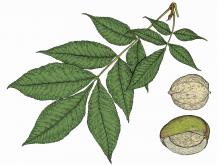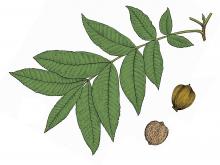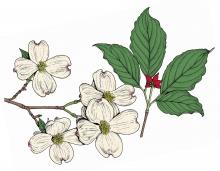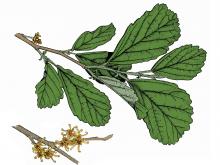Trees, Shrubs and Woody Vines
Media

Species Types
Scientific Name
Carya laciniosa
Description
Shellbark hickory is the largest of the true hickories and has the best-tasting hickory nuts in Missouri. Compared to shagbark hickory, it has larger leaves and more leaflets, plus larger nuts and orange twigs.
Media

Species Types
Scientific Name
Carya glabra
Description
A rugged tree of dry upland forests in the eastern Ozarks, the pignut hickory has pear-shaped fruits with thin husks. Settlers were unimpressed with the nuts’ flavor and fed them to their hogs!
Media

Species Types
Scientific Name
Carya aquatica
Description
Water hickory grows on ground that is often under water during part of the year. The bitter nuts are consumed by ducks and other wildlife.
Media

Species Types
Scientific Name
Cornus florida
Description
Flowering dogwood is a beautiful shrub to small tree with a straggling, spreading crown. Missouri’s official state tree, it presents lovely boughs of white inflorescences in springtime forests.
Media

Species Types
Scientific Name
Ilex decidua
Description
Possum haw, or deciduous holly, is the more common of two native Missouri hollies that lose their leaves each fall. This shrub or small tree is eye-catching in the fall and winter with its bright red berries.
Media

Species Types
Scientific Name
Liriodendron tulipifera
Description
Though it only occurs naturally in the southeastern part of Missouri, the stately tulip tree is planted widely in lawns, parks, and cemeteries. The distinctive leaves and tulip-shaped flowers make it easy to identify.
Media

Species Types
Scientific Name
Celtis occidentalis
Description
Common hackberry is named for its sweet, purple, edible fruits, but most people identify hackberry with its weird-looking bark, which develops numerous corky, wartlike projections and ridges.
Media

Species Types
Scientific Name
Asimina triloba
Description
“Way down yonder in the pawpaw patch” is an old song you might be familiar with — but today, surprisingly few Missourians know a pawpaw tree when they see one. This is a good tree to know, especially when the large, sweet fruit are ripening!
Media

Species Types
Scientific Name
Diospyros virginiana
Description
Persimmon is best known in the fall, when its orange, plumlike fruits come on. Be careful, however, to make sure a persimmon is ripe before you pop it into your mouth, or you could have a puckery surprise!
Media

Species Types
Scientific Name
Hamamelis vernalis
Description
Ozark witch-hazel is a large native shrub that grows along dry, rocky streambeds in southern and east-central Missouri. The yellow, ribbonlike flowers bloom as early as January. In the fall, the seeds are ejected forcefully, to a distance of up to 30 feet!
See Also
About Trees, Shrubs and Woody Vines in Missouri
There are no sharp dividing lines between trees, shrubs, and woody vines, or even between woody and nonwoody plants. “Wood” is a type of tissue made of cellulose and lignin that many plants develop as they mature — whether they are “woody” or not. Trees are woody plants over 13 feet tall with a single trunk. Shrubs are less than 13 feet tall, with multiple stems. Vines require support or else sprawl over the ground.





















